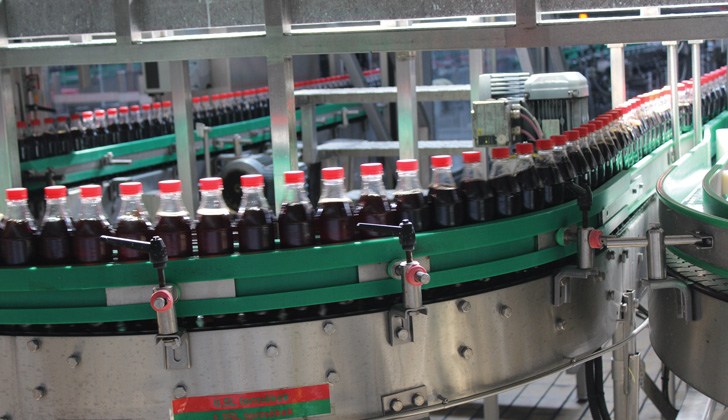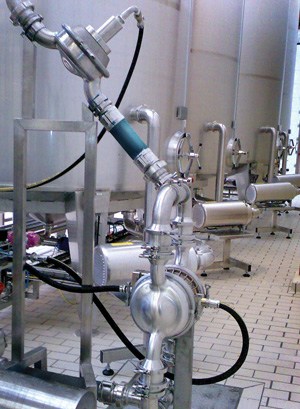By Tom Zuckett, Regional Manager for Wilden, a brand of PSG
and Grant Gramlich, Americas – Market Manager Hygienic for PSG
Source: Processing Magazine

Manufacturers of carbonated soft drinks, fruit juices, teas and energy drinks are discovering that the most reliable, safe and energy-efficient technology for these operations are air-operated double-diaphragm (AODD) pumps, in many cases Saniflo™ Hygienic™ Series (HS) and FDA models from Wilden®.
The United States landscape is dotted with soft-drink production facilities, commonly known as canning and bottling plants that blend high-fructose corn syrup, various concentrates, different flavorings and phosphoric acid to create products that are ready for consumption. In many instances, the global soft-drink market’s large multinational companies contract with bottling companies to produce their soft drinks in accordance to their tried-and true formulas. There are also littler mom-and-pop operations that produce on a less-grand scale, but still require the assistance of the canning and bottling company.
What these soft-drink production operations have in common is that strict manufacturing protocols must be followed so that the finished product lives up to the brand’s standards for look, mouth feel and taste. Therefore, achieving the desired end-product requires carbonated soft drinks to be manufactured according to a strict regimen:
- Common tap water is treated so that any impurities that may affect taste or color are removed
- The treated water is sterilized to destroy any bacteria or organic compounds it may still contain
- After the sterilized water “rests” in a storage tank, it runs through an activated-carbon filter that de-chlorinates it
- A pre-mixed concentrate is pumped into a dosing station, where it combines with the water
- This concentrate/water mixture moves to a batch tank where it is blended to form the base of the soft drink and then flash pasteurized
- The mixture passes through a carbonator that adds carbonation at predetermined levels according to the soft drink’s recipe
- The finished product is transferred to filling lines where it is injected into bottles and cans
- The cans and bottles are packed into cartons or trays for shipment to distributors, who forward them to store shelves and into the hands of consumers

Wilden® Saniflo™ Hygienic™ Series (HS) and FDA AODD Pumps offer a number of operational benefits that make them better suited for soft-drink production than centrifugal pumps, including seal-less design, dry-run capability, shear-sensitivity and higher energy efficiency.
Transfer pumps are required at throughout this production and supply chain, and the traditional pump technology of choice for bottlers and canners has been the centrifugal-style pump. However, while centrifugal pumps may have a lower purchase cost than positive displacement (PD) pumps, they have operational inefficiencies that can lead to higher lifetime costs. For instance, centrifugal pumps are not self-priming, can falter when pumping high-viscosity liquids, cannot deadhead or run dry, feature leak-prone mechanical seals and are powered by electric motors that must be kept dry.
A much better option for the numerous liquid-handling links in the carbonated soft-drink production chain is the air-operated double-diaphragm (AODD) pump. Specifically, the Saniflo™Hygienic™ Series (HS) and Saniflo™ FDA AODD Pumps from Wilden® Pump and Engineering Co., Grand Terrace, CA, USA, have been engineered to meet the highest standards for operation in the manufacture of carbonated soft drinks.
The design and operation of Wilden’s HS and FDA AODD give them the versatility to pump a wide range of viscosities and shear-sensitive products, and are perfect for the corn syrups, phosphoric acids, concentrates and flavorings that are prominent in the production of soft drinks. The HS model employs a straight-through flow design and both have Triclamp®-style fittings that ensure that desired flow rates are achieved. The wetted-path material is 316L stainless steel with interior-polish levels that range from 0.8 to 1.3 μm (31.5 to 51.2 μin) for ease of cleaning.
The free-draining flow path, wash-friendly clamp bands and clean-in-place (CIP) capability have also enabled Wilden’s HS and FDA AODD pumps to earn certifications from 3A, EHEDG, FDA CFR 21.177, USP Class VI and EC 1935/2004.
Additionally, Wilden’s next-generation diaphragm and air distribution system (ADS) technology can further optimize the operation of its HS and FDA pump models:
• Pure-Fuse Diaphragms — Combines food-grade plastics and elastomers with a stainless-steel core in a patented configuration that uses no adhesives or nylon fabric that can contaminate process fluids in the event of a breech.
• Stainless-Steel Pro-Flo® SHIFT ADS — Allows the HS and FDA pumps to be used in a wider range of hygienic or sanitary liquid-handling operations, all while consuming up to 60% less air than competitive pump models
Conclusion
No matter the design or formulation of soft drinks, they will only satisfy the consuming public if they achieve long-held standards for appearance and taste. That’s why Wilden Hygienic and FDA AODD pump models are a wise choice for the many liquid-transfer points in soft-drink production and packaging. Using AODD pumps can help guarantee that product quality is preserved, while also lower operating and maintenance costs.